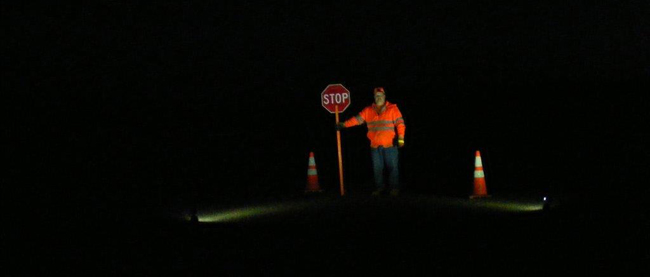

Mike Terry demonstrates how emergency flagging station lights function at a distance of 50 yards away.
D3 develops lighting for emergency flagging
In District 3, crews have come up with a way to perform traffic control in emergency situations, while also ensuring the safety of nearby motorists.
Safety Compliance Officer Eric Copeland explained that flagging at night on accidents and emergency situations is dangerous, as flaggers use flares to mark their flagging station and try to position their maintenance trucks so headlights shine on the flagger, illuminating the person without blinding the flagger or oncoming vehicles.
"Crews try to set up floodlights and generators in the dark, and hope drivers see the retro-reflective clothing in their headlights as they approach the flagging station," explained Copeland.
Transportation Tech Mike Terry (pictured right), with the Council maintenance shed, came up with the idea of using battery powered LED work lights to light up his flagging station at night. Foreman Robin Freeman saw the value in Mike’s idea and helped him make it happen.
“This solution is portable and available in all vehicles, so flagging can be deployed quickly without returning to the yard to gather needed equipment,” said District 3 Engineer Amy Revis.
“This really is a good idea that came about during something we face on a regular basis — an emergency situation on the highway,” Terry said.
The lights run longer than four hours on a single charge, and come with a cigarette-lighter adapter so they can be recharged in the field.
“This is a great idea! Mike’s lights help keep him, his crew and the motoring public safer in emergency situation,” Copeland said. “The solution was simple, economical and easy to duplicate in any maintenance shed that wants to copy the idea. My hat’s off to the crew in Council.”
Published 09-29-17